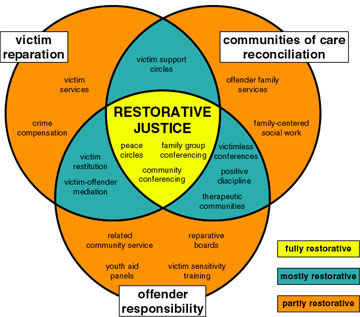 Restorative Practices TypologyHere's a visual presentation from a paper presented by Paul McCold and Ted Wachtel at the XIII World Congress of Criminology, August 10-15, 2003 in Rio de Janeiro. The chart above and text below describe how three primary stakeholders – victims, offenders and communities of care – must all be included in a process for it to be considered fully restorative. If some but not all of those stakeholders are included, the process may be partially restorative. Comments?
Restorative Practices TypologyHere's a visual presentation from a paper presented by Paul McCold and Ted Wachtel at the XIII World Congress of Criminology, August 10-15, 2003 in Rio de Janeiro. The chart above and text below describe how three primary stakeholders – victims, offenders and communities of care – must all be included in a process for it to be considered fully restorative. If some but not all of those stakeholders are included, the process may be partially restorative. Comments?
Restorative justice is a process involving the primary stakeholders in determining how best to repair the harm done by an offense. The three primary stakeholders in restorative justice are victims, offenders and their communities of care, whose needs are, respectively, getting reparation, taking responsibility and achieving reconciliation. The degree to which all three are involved in meaningful emotional exchange and decision-making is the degree to which any form of social discipline can be termed fully “restorative.” These three sets of primary stakeholders are represented by the three overlapping circles in Figure 3. The very process of interacting is critical to meeting stakeholders’ emotional needs. The emotional exchange necessary for meeting the needs of all those directly affected cannot occur with only one set of stakeholders participating. The most restorative processes involve the active participation of all three sets of primary stakeholders.
When criminal justice practices involve only one group of primary stakeholders, as in the case of governmental financial compensation for victims, the process can only be called “partly restorative.” When a process such as victim-offender mediation includes two principal stakeholders but excludes their communities of care, the process is “mostly restorative.” Only when all three sets of primary stakeholders are actively involved, such as in conferences or circles, is a process “fully restorative.”
Read the full article here.
